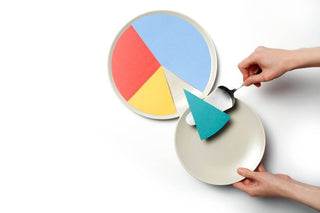What does it take to feel satisfied: the whole candy bar or just a bite? If you guessed the whole thing, you might be surprised to learn that you can be content with less.
A recent study found that smaller portions could satisfy just as well as larger portions.
Researchers offered two groups different portion sizes of snack foods and asked them to rate their hunger before eating and 15 minutes after eating. The first group was given large portions of food like chocolate, apple pie, and potato chips totaling 1,370 calories, and the smaller group was given smaller portions of the same foods totaling 195 calories.
The results? The people given larger portions ate 77% more food and about 103 additional calories compared to the smaller portion group. But, their feelings of satiety were neither stronger nor more significant than those given smaller portions, showing that smaller portions can stave off hunger and help prevent overeating, especially for those looking to lose weight.
The researchers behind this study have also found that:
- A person will eat about 92% of the food they serve themselves.
- The average person makes more than 250 food-related decisions every day.
- Low-fat labels lead people to eat 16-23% more total calories.
- The person who buys and prepares a household’s food influences about 72% of all the food eaten by their family.
- People, including professional bartenders, pour 28% more liquid into short, wide glasses than tall ones.
- 50% of snack food bought in bulk is eaten within six days of purchase.
Tips for Portion Control
Clearly, a lot of us have trouble with portion control for a variety of reasons. If you’re looking for easy ways to keep your portions in check, here are some easy-to-follow and easy-to-remember pointers:
Pick the Right Plate
Everything from the size and color of your plate can influence how much you eat...or overeat.
It’s no surprise that using a larger dish means we serve ourselves more food – 31% more, in fact – and larger serving utensils account for 14.5% larger portions.
Another study found that plate color matters: people served themselves 22% more food when the food was plated on a similarly-colored dish (think spaghetti on a red plate), compared to when food was served a high-contrast plate, like brightly-colored veggies on a white plate.
Ditch the Bag or Box
A lot of us aren’t good at self-regulating, so eating snacks directly from the bag or box almost always leads to overeating. We’re likely to eat 50% more chips than we would have if we had visual cues to show us a correct portion.
When you’re at the store, look for individually packaged single-serving bags of snacks. Or if you like to buy the big bag or box, use small containers or baggies to divide everything into your own single-serving bags. This way, you know that each portion is just enough.
Become a Portion Pro
Regularly dividing your food and snacks into single-serving portions will help you learn to easily eyeball the right portion size.
For many packaged foods, the Nutrition Facts label will tell you exactly how much of the food equals one serving. By portioning it out and putting it on an empty plate or in a bowl, you can learn what appropriate servings look like.
Knowing the right portion size for a variety of foods without labels isn’t as hard as it seems when you compare them to familiar things. Here are some common single-serving comparisons to help you remember:
- Veggies - About the size of your fist
- Pasta - About the size of ½ a baseball
- Meat, fish, or poultry - About the size of a deck of cards or your palm (without fingers)
- Snacks like pretzels or chips - A cupped handful
- Fruits like an apple or orange - About the size of a baseball
- Potato - About the size of a computer mouse
- Bagel - About the size of a hockey puck
- Pancake or waffle - About the size of a CD
- Steamed rice - About the size of a muffin liner or cupcake wrapper
- Cheese - About the size of a pair of dice or your thumb
- Fats and oils - About the size of a poker chip
Have A Restaurant Game Plan
Portions at restaurants tend to be oversized, but portion control is easy when you have a plan in place. If the menu offers a half-sized portion, you’ve already cut the calories in half. If full-sized is your only option, ask for a takeout container before you eat and leave an appropriate portion on your plate. Ask your server to clear the plates when you’re done, so you don’t keep eating mindlessly. And if you’re a dessert person, it’s always sweet to share!
Avoid These
Did you know that solid fats (like butter, margarine, milk fats, animal fat, hydrogenated and partially hydrogenated oils) and added sugars account for about 800 of the calories we consume each day? That’s nearly half the daily calories an average woman should be getting and about one-third of the daily calories an average man should be consuming, meaning we are exceeding appropriate portions. Solid, trans, and saturated fats are not only high in calories but are also some of the worst things we can consume health-wise, so it’s best to avoid them as much as possible.
It’s not always about how much we eat, but rather how much satisfaction we get from what we eat. So keep your portions in check, and you can have a little bit of this, a little bit of that, and a lot of control over your health, weight, and diet, while still feeling satisfied.

